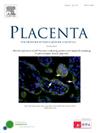Perturbation of the ovine placental transcriptome occurs at sub-therapeutic exposures to antenatal steroid therapy
IF 2.5
2区 医学
Q2 DEVELOPMENTAL BIOLOGY
引用次数: 0
Abstract
Introduction
Antenatal steroid (ANS) therapy accelerates preterm lung maturation. Clinical and experimental data show current regimens disrupt placental function and transport and impact fetal growth. We have previously shown that higher materno-fetal steroid exposures increase fetal glucocorticoid clearance. Using a sheep model, we aimed to determine whether: (i) placental transcriptomic changes correlate with fetal glucocorticoid exposure; (ii) these changes persist below the threshold for lung maturation; and (iii) transcriptomic changes explain altered steroid clearance and fetal growth.
Methods
This secondary analysis included singleton fetuses delivered at 123 ± 1 days’ gestation (n = 6/group), ventilated for 30-min, then euthanized. Fetuses received a 48-h infusion targeting plasma betamethasone levels of 2, 1, or 0.5 ng/mL, a control group received saline. Placental tissue was collected for RNA sequencing, fetal liver for qPCR and betamethasone concentrations were measured by LCMS.
Results
Maximal lung maturation occurred at 2 ng/mL. Placental transcriptome changes were dose-dependent, with 2052, 408, and 498 differentially expressed genes in the 2, 1, and 0.5 ng/mL groups, respectively. KEGG analysis showed suppression of DNA replication, nucleocytoplasmic transport, and cell cycle (p < 0.001), and activation of steroid hormone biosynthesis pathways, including upregulation of UGT1A4 and CYP17A1. Placental transporters SLC4A10, SLC7A3, SLC36A3, SLC46A1 and SLC6A3 were downregulated at 2 ng/mL. In the fetal liver, expression of transport protein ABCB1 increased across all treatment groups.
Discussion
Placental transcriptomic disruption persisted at and below the ANS exposure necessary for lung maturation. These findings suggest placental involvement in both impaired fetal growth and steroid clearance and underscore the need to optimize ANS dosing.
绵羊胎盘转录组的扰动发生在亚治疗暴露于产前类固醇治疗
产前类固醇(ANS)治疗加速早产儿肺成熟。临床和实验数据表明,目前的方案破坏胎盘功能和运输和影响胎儿生长。我们以前已经表明,较高的母胎类固醇暴露增加胎儿糖皮质激素清除率。使用绵羊模型,我们旨在确定:(i)胎盘转录组变化是否与胎儿糖皮质激素暴露相关;(ii)这些变化持续低于肺成熟阈值;(iii)转录组学改变解释了类固醇清除和胎儿生长的改变。方法对妊娠123±1天分娩的单胎胎儿(n = 6/组)进行二次分析,通气30分钟后安乐死。胎儿以血浆倍他米松水平2、1或0.5 ng/mL为目标输注48小时,对照组输注生理盐水。收集胎盘组织进行RNA测序,收集胎儿肝脏进行qPCR,采用LCMS检测倍他米松浓度。结果2 ng/mL时肺成熟最大。胎盘转录组的变化是剂量依赖性的,在2、1和0.5 ng/mL组中分别有2052、408和498个差异表达基因。KEGG分析显示,DNA复制、核质转运和细胞周期受到抑制(p < 0.001),类固醇激素生物合成途径被激活,包括UGT1A4和CYP17A1的上调。胎盘转运体SLC4A10、SLC7A3、SLC36A3、SLC46A1和SLC6A3在2 ng/mL时下调。在胎儿肝脏中,转运蛋白ABCB1的表达在所有治疗组中都有所增加。胎盘转录组破坏在肺成熟所必需的ANS暴露下持续存在。这些发现提示胎盘参与胎儿生长受损和类固醇清除,并强调优化ANS剂量的必要性。
本文章由计算机程序翻译,如有差异,请以英文原文为准。
求助全文
约1分钟内获得全文
求助全文
来源期刊

Placenta
医学-发育生物学
CiteScore
6.30
自引率
10.50%
发文量
391
审稿时长
78 days
期刊介绍:
Placenta publishes high-quality original articles and invited topical reviews on all aspects of human and animal placentation, and the interactions between the mother, the placenta and fetal development. Topics covered include evolution, development, genetics and epigenetics, stem cells, metabolism, transport, immunology, pathology, pharmacology, cell and molecular biology, and developmental programming. The Editors welcome studies on implantation and the endometrium, comparative placentation, the uterine and umbilical circulations, the relationship between fetal and placental development, clinical aspects of altered placental development or function, the placental membranes, the influence of paternal factors on placental development or function, and the assessment of biomarkers of placental disorders.
 求助内容:
求助内容: 应助结果提醒方式:
应助结果提醒方式:


